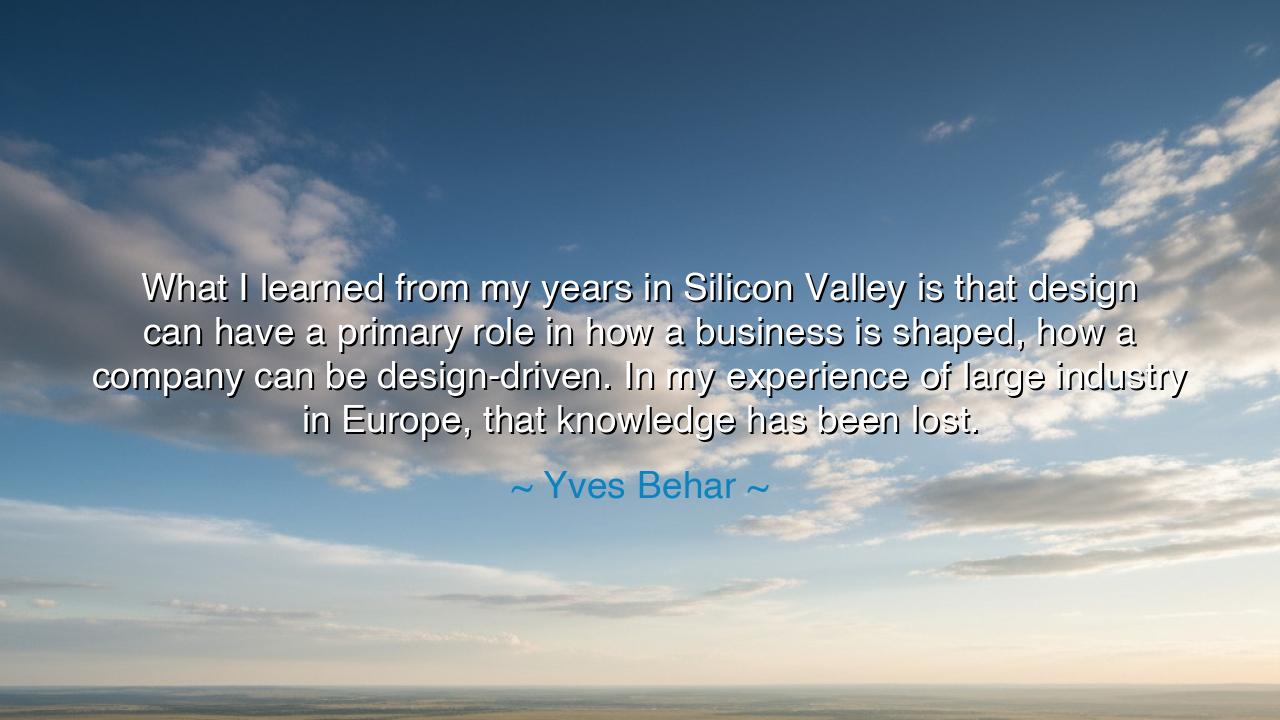
What I learned from my years in Silicon Valley is that design can
What I learned from my years in Silicon Valley is that design can have a primary role in how a business is shaped, how a company can be design-driven. In my experience of large industry in Europe, that knowledge has been lost.






“What I learned from my years in Silicon Valley is that design can have a primary role in how a business is shaped, how a company can be design-driven. In my experience of large industry in Europe, that knowledge has been lost.” Thus spoke Yves Béhar, a modern sage of creation and innovation, whose life has been a dialogue between two worlds—the daring frontier of Silicon Valley, and the old citadels of European industry. In this reflection, Béhar laments not merely a difference in method, but a difference in spirit. He speaks of a truth that echoes through all ages of human endeavor: that when design—the union of imagination, purpose, and empathy—leads the way, the world transforms. When it is neglected, innovation withers, and industry becomes hollow.
To understand Béhar’s words, one must understand what he means by design-driven. In Silicon Valley, the birthplace of modern dreams, design is not an afterthought; it is the beating heart of creation. There, design shapes not only the look of a product, but its soul—its function, its meaning, its relationship to human life. It asks the question: How can we make this better for the world, not just for profit? In that crucible of ideas, companies like Apple, Tesla, and Airbnb arose not by accident, but through devotion to this principle—that design, guided by empathy and imagination, could redefine the very nature of business itself.
When Béhar speaks of “large industry in Europe,” he speaks with the sorrow of one who has seen beauty lose its vitality. For Europe, once the cradle of design excellence—from the artistry of Leonardo da Vinci to the functional grace of the Bauhaus—had allowed the flame of design leadership to dim beneath bureaucracy and caution. Where once form and function danced in harmony, now they were divided by fear of change. The knowledge that design is not simply surface, but strategy, had been forgotten. Béhar’s lament is not a critique of a continent—it is a warning to all who trade vision for comfort, and innovation for tradition.
Throughout history, every era of progress has been led by those who placed design—the intelligent shaping of reality—at its core. The architects of the Renaissance, who rebuilt civilization after centuries of darkness, began not with commerce, but with vision. They designed not just buildings, but ideals; not just tools, but ways of living. In the 20th century, men like Walter Gropius and Le Corbusier declared that design could unify art and industry, that every object and structure could uplift the human spirit. Béhar stands in this same lineage. His words remind us that when design leads, humanity rises; when it is ignored, progress stagnates.
Consider the tale of Steve Jobs, whose partnership with the designer Jony Ive birthed a revolution not only in technology, but in how companies think. Jobs believed that design was not a department, but a philosophy. Every curve of a product, every touch of a button, every light on a screen was crafted with intention—to make technology humane, approachable, alive. He built Apple not as an engineer’s company, but as a design-driven one, where every decision began with the question: What will the user feel? It was this devotion to beauty and purpose that turned devices into icons and customers into believers. Béhar, who walked those same corridors of innovation, learned that such reverence for design could transform not only products, but entire cultures of enterprise.
Yet Béhar’s quote carries both hope and warning. He shows us that design-driven thinking is not limited to technology—it can and must be applied to every human pursuit. Whether one builds machines, cities, or systems of education, design—that deliberate shaping of the world through empathy and creativity—should be the guiding light. When organizations forget this truth, when they reduce design to mere aesthetics or decoration, they lose the power to connect with the hearts of people. Innovation without humanity becomes machinery; progress without design becomes chaos.
So, my listener, take this teaching into your own labor, whatever it may be. Let design-thinking—the pursuit of beauty, clarity, and purpose—be the compass of your craft. Before you build, ask yourself: Whom does this serve? What experience does it create? Do not separate creativity from practicality, nor art from enterprise, for they are twins born of the same soul. Be not afraid to challenge the structures that have forgotten this wisdom. As Béhar teaches, when design leads, we do not merely improve what exists—we reshape the future.
Thus, remember the wisdom of Yves Béhar: that design is not ornament, but origin; not embellishment, but evolution. To be design-driven is to see with both mind and heart—to imagine not only what can be made, but what should be made. If Europe lost that knowledge, then it falls upon us to recover it; if the world has grown careless with its tools, let us craft anew with reverence. For design, in its truest form, is the art of building not just things, but meaning—and through meaning, destiny itself.






AAdministratorAdministrator
Welcome, honored guests. Please leave a comment, we will respond soon